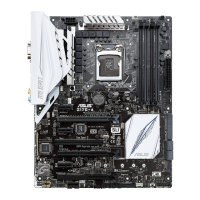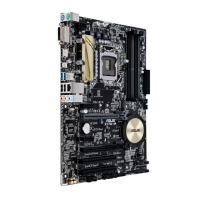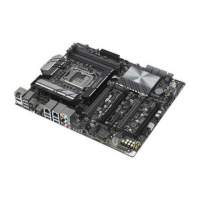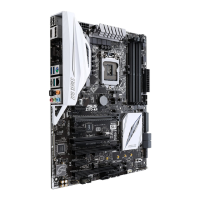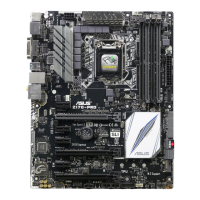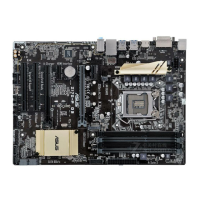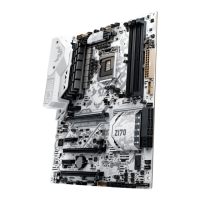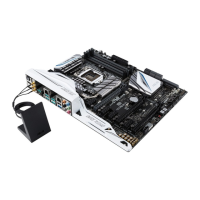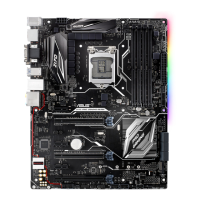Do you have a question about the Asus Z170-E and is the answer not in the manual?
Precautions to prevent electrical shock hazards during system operation.
Guidelines for safe handling and operation of the motherboard and components.
Precautions before installing components or changing settings.
Information about the CPU socket and installation.
Step-by-step visual guide for installing the CPU.
Further steps for installing the CPU.
Instructions for installing the CPU heatsink and fan.
Overview of the motherboard's DIMM slots and memory support.
Details on the number of DIMM slots and DDR4 module compatibility.
Step-by-step guide for installing and removing memory modules.
Function of the MemOK! button for memory compatibility tuning.
Recommendations and guidelines for installing memory modules.
Introduction to the UEFI BIOS and its functions.
How to enter and navigate the BIOS setup program.
Overview of the EZ Mode interface and its functions.
Introduction to the Advanced Mode interface for detailed configuration.
Setting fan profiles and operating speeds for CPU and chassis fans.
Steps to manually configure fan speed and operating points.
Using EZ Tuning Wizard for overclocking, RAID setup, and fan tuning.
Steps to create a RAID configuration using EZ Tuning Wizard.
Selecting RAID types (Easy Backup, Super Speed) and completing setup.
Personalizing the BIOS screen by saving favorite items.
Procedures for adding BIOS items to the My Favorites screen.
Overview of system information and basic settings in the Main menu.
How to set, change, or clear the administrator password.
Menu for configuring overclocking-related items.
Selecting CPU overclocking options (Auto, Manual, XMP).
Maximizing overclocking performance with ASUS core ratio settings.
Setting the memory operating frequency.
Configuring primary DRAM timings like CAS Latency and RAS to CAS Delay.
Adjusting signal timing for improved stability and performance.
Controls for DRAM RTL and IOL parameters.
Adjusting IO latency offsets for CHA and CHB.
Miscellaneous DRAM timing and control settings.
Adjusting CPU power delivery and VRM settings.
Controlling VRM duty based on thermal balance.
Setting power phase control for GT.
Managing CPU power and features like SpeedStep and Turbo Mode.
Advanced overclocking settings for BCLK and voltages.
Setting maximum current limit for CPU graphics.
Setting CPU System Agent voltage.
Changing settings for CPU and other system devices.
CPU-related information detected by BIOS.
Improving performance by prefetching CPU data.
Enabling or disabling CPU C6 report to the OS.
Procedures for updating the motherboard BIOS.
Updating BIOS, drivers, and software in Windows.
Updating BIOS via USB flash drive or internet.
Steps to update BIOS using a USB flash drive.
Steps to update BIOS using an internet connection.
Restoring BIOS from support DVD or USB drive.
Options for setting and managing BIOS passwords.
How to set or clear a user password for system access.
Setting the base clock frequency for system performance.
Setting CPU core ratio limits per core or synchronizing all cores.
Automatically overclocking CPU and DRAM frequencies and voltage.
Configuring secondary DRAM timings for performance tuning.
Configuring RFR delay for IO latency.
Setting CPU power phase control modes.
Configuring boot voltages for CPU, DMI, and System Agent.
Setting the minimum CPU cache ratio.
Selecting CPU graphics voltage mode (Auto, Manual, Offset).
Improving performance by prefetching adjacent cache lines.
Changing the BCLK to DRAM frequency ratio.
Configuring ASUS EPU for minimum power consumption.
Configuring various third-level DRAM timing parameters.
Calibrating load-line for CPU graphics voltage.
Setting the maximum CPU cache ratio.
Setting PCH Core voltage.
Selecting CPU performance state during boot.
Enabling or disabling odd ratio mode for DRAM granularity.
Stopping CPU communication with external voltage regulator.
Setting current capability for GT overclocking.
Setting the CPU graphics ratio.
Setting CPU standby voltage.
Managing CPU power consumption and states.
Setting DRAM timing control features.
Adjusting switching frequency for CPU graphics.
Enabling higher voltages for overclocking, with risk to CPU lifetime.
Controlling DRAM reference voltages.
Configuring CPU core/cache voltage modes.
Setting DRAM voltage.
Setting CPU VCCIO voltage.
Steps to start the OC Tuning process.
Calibrating CPU load-line for voltage stability.
Enabling hyper-threading for multiple logical processors.
Setting the power range for CPU overclocking.
Selecting the number of active CPU cores.
Adjusting VRM switching frequency for transient response.
Enabling virtualization technology for hardware capabilities.
| Chipset | Intel Z170 |
|---|---|
| Socket | LGA 1151 |
| Form Factor | ATX |
| Memory Slots | 4 |
| Memory Type | DDR4 |
| Maximum Memory | 64 GB |
| Memory Speed | DDR4 3466(O.C.)/3400(O.C.)/3333(O.C.)/3300(O.C.)/3200(O.C.)/3000(O.C.)/2800(O.C.)/2666(O.C.)/2400(O.C.)/2133 MHz |
| PCI Express x16 Slots | 2 |
| PCI Express x1 Slots | 3 |
| SATA Ports | 6 x SATA 6Gb/s |
| M.2 Slots | 1 |
| USB 3.0 (Gen 1) | 6 |
| USB 2.0 | 6 |
| Audio | Realtek ALC887 8-Channel High Definition Audio CODEC |
| LAN | Intel I219V, 1 x Gigabit LAN Controller(s) |
| RAID Support | RAID 0, 1, 5, 10 |
| Multi-GPU Support | AMD CrossFireX |
| USB 3.1 (Gen 2) | 2 (1 x Type-A + 1 x Type-C) |
